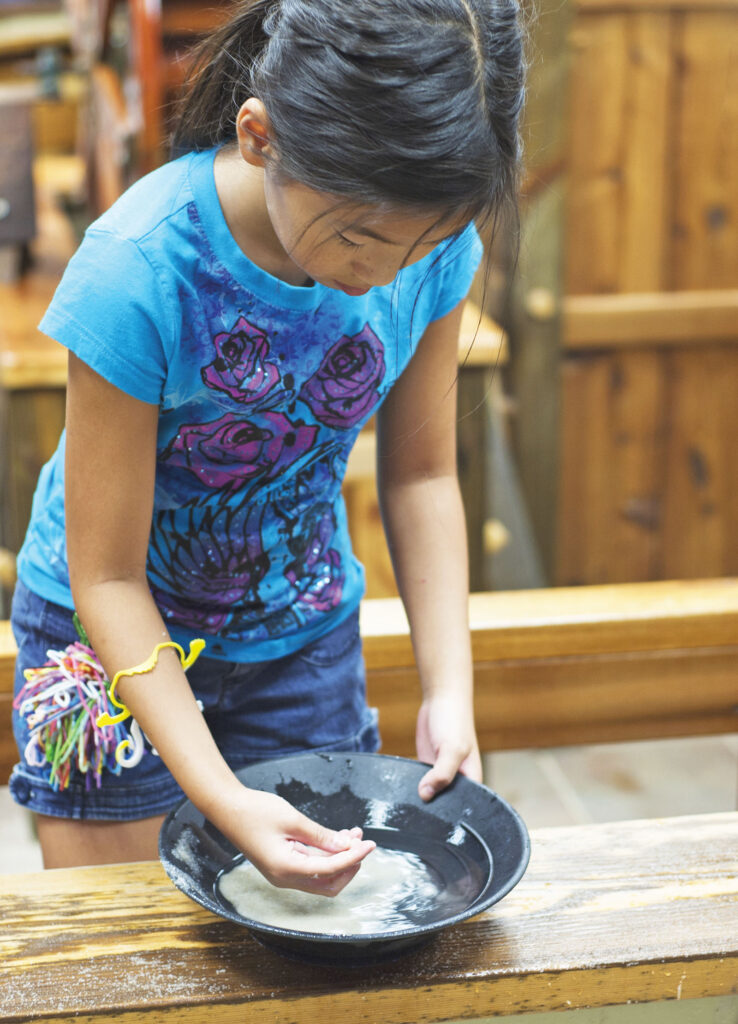Article:
…to keep your child engaged over the summer
BY JANICE LEWINE
Summer is in full swing, which means plenty of sun and fun. While these lazy days offer endless playtime for kids, they can also usher in the phenomenon known as “summer slide,” which is a regression in academic proficiency that many students experience when school is not in session. Take advantage of these stimulating activities—many of which can be done at home or locally in the Triangle—that will engage your child’s mind and turn summer’s brain drain into a brain gain!
1. Read. Reading is essential for kids to maintain their language and comprehension skills while school is out. Reading stimulates the brain, increases knowledge, reduces stress and teaches empathy. Whether it’s a picture book, novel, biography or book series, have your child read for at least 20 minutes a day. Find a good read at your local library or bookstore. (Be sure to check out our story about independent booksellers in the Triangle).
2. Take a StoryWalk. StoryWalks display laminated pages from a children’s book along a walking path. As you stroll, the story unfolds as you’re directed to the next page. StoryWalks often feature activity prompts to encourage movement and discovery. Visit the parks and recreation website for your city or town to find a StoryWalk near you.
3. Explore a local park. North Carolina boasts numerous parks and greenways for kids to explore while enjoying physical activity. Two new parks will open this summer in Apex and Raleigh that will expand young minds: Pleasant Park, located at the intersection of I-540 and Old U.S. Highway 1 in Apex, fosters creative exploration in eight inclusive play villages and a water play facility inspired by fairy tales and folklore. North Carolina Freedom Park, located at the corner of North Wilmington and East Lane streets in downtown Raleigh, features wall inscriptions, walkways and structural elements that honor African American struggles and triumphs in pursuit of freedom
and equality.
4. Stroll among the sunflowers. Sunflower fields
serve as pollinator habitats for bees and other species. These large flowers make it easy to identify their
integral parts and, once harvested and processed, sunflower seeds create biodiesel. Sunflowers generally peak in July in North Carolina. Raleigh boasts two large fields. One is within Dorothea Dix Park at 75 Hunt Drive (dixpark.org/sunflowers) and another is on the property of the North Carolina Museum of Art at 2110 Blue Ridge Road (ncartmuseum.org/series/city-of-sunflowers). Admission to both fields is free.

6. Discover a geocache. Take your child’s thrill of the hunt a step farther by geocaching. In this outdoor adventure participants use apps, such as Geocaching or Cachly, to locate cleverly hidden containers that contain small treasures such as keychains and small toys, and a logbook they can sign. Geocaching teaches kids how to navigate their surroundings, use technology to crack clues, work with others to find a cache and practice etiquette (if you take something from a cache, leave something of equal or greater value.)
7. Go birding. North Carolina is home to more than 475 wild bird species including songbirds, hawks, herons, owls and more. Watching birds as they forage for food, preen themselves and utter their distinctive sounds connects kids with nature and expands their identification skills. Learn to identify bird species using a field guide or app, and create a simple bird feeder using a pine cone covered in peanut butter and birdseed to attract them to your yard.
8. Stargaze. Observe stars, planets and constellations to increase your child’s knowledge of the night sky. Three of the season’s most prominent constellations in the Northern Hemisphere are Hercules, Cygnus and Lyra. Certain planets, depending on their orbit, are often visible with the naked eye. Three supermoons make their appearance July 3, August 1 and August 30. Even counting the twinkling stars is educational. Free celestial charts are available online.
9. Dig for treasure. Mining is a fun way for kids to uncover gems, minerals, fossils and shells of the earth. Identifying these geologic finds is an enlightening experience. Find treasure at Treasure Quest Mining in Apex, Spring Haven Farm in Chapel Hill, Blue Diamond Gemstone Panning in Cary and Xtreme Park Adventures in Durham. Head west toward Charlotte to pan for gold at Reed Gold Mine, a former working mine in Midland open for tours Tuesday–Saturday. Keep heading west and you’ll reach Gem Mountain in Spruce Pine, which offers flume mining and mining trips to two secluded mines.

10. Take an educational road trip. Museums, heritage sites and nature centers throughout North Carolina feature educational displays, historical interpretations, interactive exhibits and hands-on activities to discover the state’s history, art and natural environment. Learn more by visiting the North Carolina Department of Natural and Cultural Resources website and the North Carolina Science Trail website. Also, The North Carolina Museum of History, North Carolina Museum of Natural Sciences and North Carolina Museum of Art have joined forces to offer a summer passport program. Take a trip to one of the museums through August 31 to get your passport stamped while exploring family-friendly activities.
11. Play a classic board game. Nostalgic games like Checkers, Pictionary, Scrabble, Boggle, Scattergories, Candy Land, Chutes and Ladders, Rummikub and Clue remain effective learning tools for children, who can hone their memory, reasoning and communication skills while having fun. Physical games like Charades and Twister can enhance gross motor, color recognition, observation and problem-solving skills.

12. Unleash your inner artist. Draw, sketch or paint. Experiment with colors and textures. Spark creativity using everyday objects like fabric, rocks, popsicle sticks and paper plates—and turn them into beautiful works of art.
13. Create a scrapbook or journal. Encourage kids to preserve their memories of special occasions, vacations and family members in a scrapbook, or express their feelings in a journal. These personalized books help nourish creativity and boost memory, organizational and writing skills. These keepsakes will be even more precious as the years go by.
14. Make a graphic novel, comic strip or storyboard. Kids can develop their artistic, writing and technology skills by creating a digital graphic novel, comic book or storyboard. StoryboardThat is a drag-and-drop creation platform for comic strips and storyboards. Smilebox’s Comic Strip Maker enables kids to upload their own photos to create a comic strip they can print and share online. Pixton is an interactive platform for creating comic book storyboards using avatars, backgrounds, text and themes.
15. Grow a sensory garden. Tending to a small garden activates children’s senses, increases their planning and organizational skills, and develops their self-confidence as they care for living things. Choose colorful flowers like begonias, marigolds and zinnias; aromatic herbs like mint, basil and lemon verbena; and fuzzy plants, like chenille and lamb’s ear. Paint smooth stones to add more color and texture in the garden.
16. Discover the joy of cooking. Cooking is a life skill that builds reading, math, science and fine motor skills in kids, and increases their knowledge about nutrition and food safety. With adult supervision, young children can measure and mix ingredients, wash fruits and vegetables, crack an egg and learn to follow a recipe. Depending on their maturity level, older children can chop vegetables, juice fruits, boil items on a stove and bake foods in an oven.
17. Be an international pen pal. Practice letter-writing and language skills with a newfound friend across the globe. The joys of learning about another culture while sharing details about one’s own can be a rewarding experience. Find a pen pal through a trusted website, such as kidsforpeaceglobal.org/peacefulpenpals, epals.com or globalpenfriends.com.
18. Build financial literacy. Talk with your child about earning, saving and spending money. Teach your child how to count coins and bills, and consider age-appropriate chores they can do to earn money. Take your child shopping so he or she understands the cost of items and how money pays for them. Open a kid-friendly bank account and let your child deposit and withdraw money from it. Older children can learn about budgeting and how to divide their money among wants and needs; the advantages and disadvantages of debit and credit cards; and how mobile payment services such as Venmo, PayPal and Apple Pay work.
19. Keep skills sharp. Review notes and worksheets from the past school year, or practice reading and math on free websites like Khan Academy or Math Playground.
20. Attend a summer camp or class. Kids gain independence, confidence and a lifetime of memories as they connect with others and learn new things at camp. If a particular subject area interests your child, check out the parks and recreation websites in your city or town that focus on visual arts, performing arts, music, sports and outdoor activities being offered at local community centers and cultural arts centers.

TIPS FOR ENCOURAGING READING
Trinity School of Durham and Chapel Hill Director of Institutional Equity Shaun Satterfield, who is also a former elementary school teacher, offers these suggestions to encourage reading. “Have your child read aloud, but audiobooks are reading, too! The key is to let them listen to something that is interesting to them. Have your child limit their screen time and listen to a book while they’re cleaning their room or packing for a trip. Some reluctant readers may enjoy nonfiction, especially on topics that pique their interest. Have them read the instructions and build that bookcase you’ve been meaning to put together. The trick is to be creative, like hiding the broccoli under a creamy layer of cheese!” she says.


